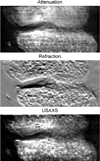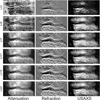Noise and analyzer-crystal angular position analysis for analyzer-based phase-contrast imaging
- PMID: 24651402
- PMCID: PMC4097604
- DOI: 10.1088/0031-9155/59/8/1877
Noise and analyzer-crystal angular position analysis for analyzer-based phase-contrast imaging
Abstract
The analyzer-based phase-contrast x-ray imaging (ABI) method is emerging as a potential alternative to conventional radiography. Like many of the modern imaging techniques, ABI is a computed imaging method (meaning that images are calculated from raw data). ABI can simultaneously generate a number of planar parametric images containing information about absorption, refraction, and scattering properties of an object. These images are estimated from raw data acquired by measuring (sampling) the angular intensity profile of the x-ray beam passed through the object at different angular positions of the analyzer crystal. The noise in the estimated ABI parametric images depends upon imaging conditions like the source intensity (flux), measurements angular positions, object properties, and the estimation method. In this paper, we use the Cramér-Rao lower bound (CRLB) to quantify the noise properties in parametric images and to investigate the effect of source intensity, different analyzer-crystal angular positions and object properties on this bound, assuming a fixed radiation dose delivered to an object. The CRLB is the minimum bound for the variance of an unbiased estimator and defines the best noise performance that one can obtain regardless of which estimation method is used to estimate ABI parametric images. The main result of this paper is that the variance (hence the noise) in parametric images is directly proportional to the source intensity and only a limited number of analyzer-crystal angular measurements (eleven for uniform and three for optimal non-uniform) are required to get the best parametric images. The following angular measurements only spread the total dose to the measurements without improving or worsening CRLB, but the added measurements may improve parametric images by reducing estimation bias. Next, using CRLB we evaluate the multiple-image radiography, diffraction enhanced imaging and scatter diffraction enhanced imaging estimation techniques, though the proposed methodology can be used to evaluate any other ABI parametric image estimation technique.
Figures









Similar articles
-
Limited-angle tomography for analyzer-based phase-contrast x-ray imaging.Phys Med Biol. 2014 Jul 7;59(13):3483-500. doi: 10.1088/0031-9155/59/13/3483. Epub 2014 Jun 5. Phys Med Biol. 2014. PMID: 24898008 Free PMC article.
-
Estimator for photon counting energy selective x-ray imaging with multibin pulse height analysis.Med Phys. 2011 May;38(5):2324-34. doi: 10.1118/1.3570658. Med Phys. 2011. PMID: 21776766 Free PMC article.
-
Dimensionality and noise in energy selective x-ray imaging.Med Phys. 2013 Nov;40(11):111909. doi: 10.1118/1.4824057. Med Phys. 2013. PMID: 24320442 Free PMC article.
-
Multiple-image radiography.Phys Med Biol. 2003 Dec 7;48(23):3875-95. doi: 10.1088/0031-9155/48/23/006. Phys Med Biol. 2003. PMID: 14703164
-
Absorption, refraction and scattering retrieval in X-ray analyzer-based imaging.J Synchrotron Radiat. 2018 Jul 1;25(Pt 4):1206-1213. doi: 10.1107/S1600577518007439. Epub 2018 Jun 17. J Synchrotron Radiat. 2018. PMID: 29979183
Cited by
-
Realistic wave-optics simulation of X-ray phase-contrast imaging at a human scale.Sci Rep. 2015 Jul 14;5:12011. doi: 10.1038/srep12011. Sci Rep. 2015. PMID: 26169570 Free PMC article.
-
Emphysema quantified: mapping regional airway dimensions using 2D phase contrast X-ray imaging.Biomed Opt Express. 2020 Jul 9;11(8):4176-4190. doi: 10.1364/BOE.390587. eCollection 2020 Aug 1. Biomed Opt Express. 2020. PMID: 32923035 Free PMC article.
References
-
- Anastasio MA, La Riviere P. Emerging imaging technologies in medicine. Boca Raton, FL: CRC Press; 2012.
-
- Arfelli F, Assante M, Bonvicini V, Bravin A, Cantatore G, Castelli E, Dalla Palma L, Di Michiel M, Longo R, Olivo A, Pani S, Pontoni D, Poropat P, Prest M, Rashevsky A, Tromba G, Vacchi A, Vallazza E, Zanconati F. Low-dose phase contrast x-ray medical imaging. Phys Med Biol. 1998;43:2845–2852. - PubMed
-
- Bonse U, Hart M. Tailless X-ray single-crystal reflection curves obtained by multiple reflection. Appl. Phys. Lett. 1965;7:238.
-
- Brankov JG, Wernick MN, Yang YY, Li J, Muehleman C, Zhong Z, Anastasio MA. Computed tomography implementation of multiple-image radiography. Med Phys. 2006;33:278–289. - PubMed
-
- Brankov JG, Zysk AM. In: Emerging Imaging Technologies in Medicine. Anastasio MA, Riviere PL, editors. Taylor & Francis; 2012. p. 368.
Publication types
MeSH terms
Grants and funding
LinkOut - more resources
Full Text Sources
Other Literature Sources
